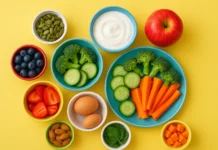Pumpkins aren’t just for Halloween — they’re a nutrient-packed powerhouse that can help your child grow strong, stay healthy, and enjoy delicious meals all year round. Parents can easily introduce pumpkins to kids of all ages, thanks to their natural sweetness and smooth texture.
Let’s explore why this bright orange food deserves a regular spot on your family’s menu.
What Makes Pumpkin So Healthy?
Pumpkin is low in calories yet loaded with vitamins, minerals, and antioxidants. It’s one of the most nutrient-dense foods you can give to your child.
| Nutrient | Key Benefits for Children |
|---|---|
| Vitamin A (beta-carotene) | Supports eye health and the immune system |
| Vitamin C | Strengthens immunity and helps in tissue repair |
| Fiber | Promotes healthy digestion and prevents constipation |
| Potassium | Aids muscle function and heart health |
| Iron | Supports red blood cell formation and energy |
| Vitamin E | Protects cells from damage |
| Magnesium | Helps with bone growth and muscle strength |
Source: Healthline – Pumpkin Nutrition Facts
Top Health Benefits of Pumpkin for Kids
Boosts Immunity
Pumpkin is rich in vitamins A and C, which help strengthen your child’s immune system, making it easier to fight off common colds and infections.Supports Eye and Vision Health
The bright orange color comes from beta-carotene, which the body converts into vitamin A — essential for good eyesight, especially as children’s eyes are developing.Improves Digestion
Pumpkin’s high fiber content promotes healthy bowel movements and can help prevent constipation, a common issue among children.Enhances Growth and Energy
With minerals like iron, potassium, and magnesium, pumpkin supports muscle growth, blood circulation, and overall energy levels for active children.Encourages Healthy Weight
Pumpkin is naturally low in calories and fat, yet very filling — a perfect ingredient to help maintain a balanced diet for kids.
Easy Ways to Add Pumpkin to Your Child’s Diet
Here are some simple, fun, and kid-approved ideas to include pumpkin in everyday meals:
- Pumpkin purée mixed with oatmeal or yogurt for breakfast
- Pumpkin pancakes or muffins as a healthy snack
- Pumpkin pasta sauce for a creamy, nutritious twist
- Pumpkin soup or porridge for a warm, comforting meal
- Pumpkin cookies or energy bites as treats without the guilt
Tip: Use fresh pumpkin when possible — but canned pure pumpkin (without added sugar) is also a great, time-saving option.
Frequently Asked Questions (FAQ)
At what age can I introduce pumpkin to my child?
You can introduce puréed pumpkin as early as 6 months, when your baby starts solids. Always ask your pediatrician for guidance before introducing unfamiliar foods to your child.
Is pumpkin safe for children with allergies?
Pumpkin allergies are rare. However, always start with small servings and observe for any reaction.
Can pumpkin help my child’s sleep?
Yes! Pumpkin contains tryptophan, an amino acid that supports better sleep by helping the body produce serotonin and melatonin.
Is canned pumpkin as healthy as fresh pumpkin?
Yes — as long as it’s 100% pure pumpkin (not pumpkin pie filling). It retains most nutrients and is convenient for quick meals.
How often can my child eat pumpkin?
It’s safe to include pumpkin several times a week as part of a varied, balanced diet.
Final Thoughts
Pumpkin is more than a festive decoration — it’s a superfood for children’s health. Packed with vitamins, minerals, and antioxidants, it helps strengthen the immune system, improve digestion, and support overall growth.
When you add pumpkin to your child’s meals, you nourish them with a natural, nutrient-packed food that promotes lifelong health — and great taste comes with it.
For more information on child nutrition, visit Harvard Health – Healthy Eating for Kids.
- 10 Kid-Friendly Superfoods Every Parent Should Know
- Bitter Melon: A Natural Weapon Against High Blood Sugar
- 10 Outstanding Health Benefits of Bitter Melon (Bitter Gourd)















